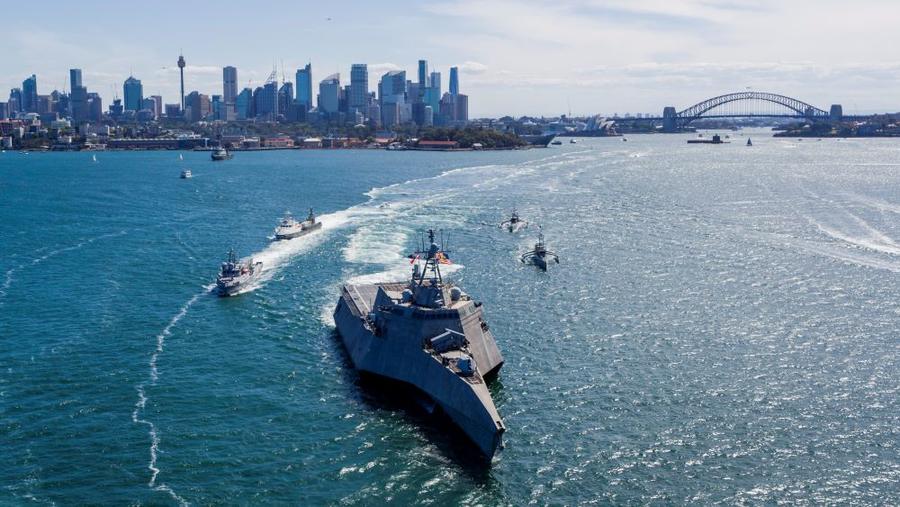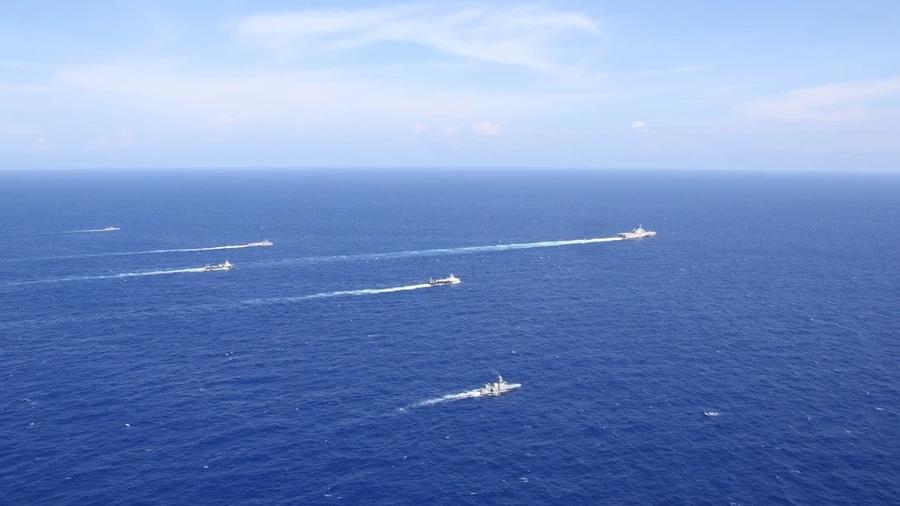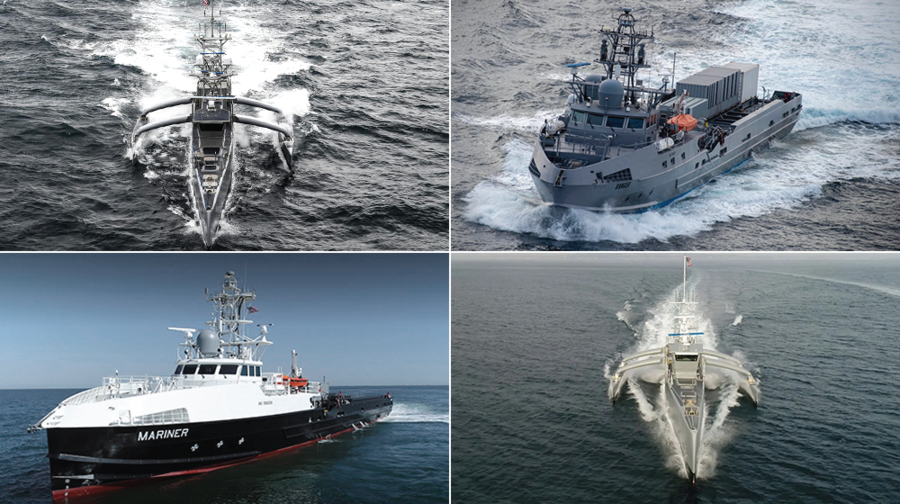U.S. Navy deployment puts Leidos autonomy on display
A U.S. Navy task group including four unmanned surface vessels (USVs) reached Sydney Harbor late last month after crossing the Pacific Ocean for the first time and visiting several western Pacific ports.
Each of the fleet’s unmanned vessels (Seahawk, Sea Hunter, Ranger and Mariner) are designed and outfitted with state-of-the-art Leidos autonomy technology.
The deployment, named Integrated Battle Problem (IBP) 23.2, marks a number of historic milestones in naval autonomy.
Retired U.S. Navy Vice Admiral David Lewis, Leidos Sr. Vice President for Maritime Operations, said it’s the first time these vessels have operated together as a task group, traveled beyond Hawaii, crossed the International Date Line, crossed the Equator and visited a Western Pacific foreign port.
Before IBP 23.2, they operated extensively in the Caribbean Sea and Panama Canal and on numerous Eastern Pacific tours.
Lewis said he sees many comparisons to President Theodore Roosevelt’s voyage of the Great White Fleet, a group of 16 U.S. Navy battleships that sailed around the world from 1907-1909 in a display of American naval power.
- “In many ways, this deployment is showing the world that the U.S. Navy has embraced autonomy, the next generation of maritime high technology,” he said. “This isn’t just a few ships out on a short cruise. This deployment brings together autonomy and multidomain task group operations. I see it as the operational debut of 21st century American technology on the world stage, which is what the Great White Fleet represented in its day.”
Lewis added that the deployment signals a transition of advanced technology out of the laboratory and prototype stages and into the heart of today’s most stressing maritime operational environment, the Western Pacific.

This deployment is showing the world that the U.S. Navy has embraced autonomy, the next generation of maritime high technology.
David Lewis
Sr. Vice President, Maritime Operations
Gerry Fasano, Leidos Defense Group President, emphasized the significance of USVs actively enhancing the fighting envelope of U.S. Navy surface combatants in an organized Surface Action Group.
- “The integration of autonomous surface vessels with manned combatants on display in this deployment will give fleet commanders much-needed enhancements to maritime domain awareness, accelerating the speed and lethality of existing maritime kill chains,” says Fasano.
An historic learning opportunity: Lewis said the deployment will reveal a lot about how autonomous vessels operate on deployment.
- “We have significant knowledge about cruisers, destroyers and submarines, which we’ve deployed for decades,” he said, “but when you do things you’ve never done before, like deploy a Surface Action Group of autonomous warships across the vast Pacific, unexpected things will happen, and that’s the point. We’re going to learn a lot, and that’s a very good thing.”
Lewis also emphasized the importance of cohesive and continuous maintenance for autonomous systems to support naval operations.
Ray Sheldon, Gibbs & Cox President, said before the deployment, Ranger and Mariner had logged nearly 100,000 miles in supervised autonomy near U.S. shores.
- “The Western Pacific has some of the roughest seas in the world,” says Sheldon, “so they’re being put to the test like never before. They’re being asked to operate dependably over a great deal of sheer distance and operational time. All four vessels have a remarkably high reliability record, but not necessarily when exposed to rough waters on the high seas, and that can make a big difference. It’s a harsher operating environment than anything we’ve tested, but these are the types of conditions we’ve been preparing for.”
Dan Brintzinghoffer, Leidos Vice President and Division Manager in the Leidos Maritime Business, said that because the deployment will last for several months, his team has positioned hundreds of spare parts aboard Ranger and Mariner.
- “Whether it’s harsh operating conditions, severe weather or other mission factors, it’s safe to say we will learn a lot during the extended time at sea," says Brintzinghoffer. “We know we will experience individual systems issues and learn from those occurrences. The question is, as you stress the system of systems, how do the vessels respond? Normally, there is crew onboard to assist if there are any system issues, but this assistance now must come in the form of an autonomous or semi-automated response. We believe we have the right parts, technology and software in place to keep system availability high.”
Meet the fleet: Sea Hunter, a fully autonomous vessel, was the first of the four ships to be completed in 2015. In 2019, Fortune called Sea Hunter “the first of a new class of warships that use artificial intelligence in place of a crew.”
Seahawk, also fully autonomous, was the second. Like Sea Hunter, Leidos designed Seahawk to be completely autonomous from the hull up. The company supervised construction of the vessel, which joined the Navy’s Surface Development Squadron One in 2021.
- “Seahawk and Sea Hunter are autonomous down to the pump, motor and engine, capable of self-reconfiguration and decision-making about how to operate apart from human guidance,” says Lewis.
Ranger, a large semi-autonomous platform, is a fast supply vessel (FSV) converted to operate autonomously by Leidos subsidiary Gibbs & Cox. Leidos purchased Ranger partially completed, selected the shipyard and oversaw the reconstruction effort.
Mariner, also semi-autonomous, is the newest ship in the fleet, a converted FSV that incorporates lessons learned from Ranger into its mechanical and electrical designs to make them more reliable and conducive to autonomy.
- “Ranger and Mariner, while not as autonomous as Seahawk and Sea Hunter, can navigate effectively without a crew, but because they weren’t originally designed for autonomy, they aren’t quite at the same level,” said Lewis. “However, these are platforms with substantial capacity. They’ve done surveillance missions, but they also have the potential to be weapons platforms.”
Looking ahead: Beyond the deployment, Lewis sees fully autonomous mission planning as the ultimate form of naval autonomy.
- “If the vessel was on a wartime mission and took damage or encountered severe weather, for example, the truly autonomous ship can replan itself to carry out the mission despite damage or equipment casualties without human reprogramming,” he said. “That’s a huge challenge, and it’s something we’re working on implementing every day at Leidos.”
Please contact the Leidos media relations team for more information.
The appearance of U.S. Department of Defense (DoD) visual information does not imply or constitute DoD endorsement.
Certain statements in this announcement constitute “forward-looking statements” within the meaning of the rules and regulations of the U.S. Securities and Exchange Commission (SEC). These statements are based on management’s current beliefs and expectations and are subject to significant risks and uncertainties. These statements are not guarantees of future results or occurrences. A number of factors could cause our actual results, performance, achievements, or industry results to be different from the results, performance, or achievements expressed or implied by such forward-looking statements. These factors include, but are not limited to, the “Risk Factors” set forth in Leidos’ Annual Report on Form 10-K for the fiscal year ended December 30, 2022, and other such filings that Leidos makes with the SEC from time to time. Readers are cautioned not to place undue reliance on such forward-looking statements, which speak only as of the date hereof. Leidos does not undertake to update forward-looking statements to reflect the impact of circumstances or events that arise after the date the forward-looking statements were made.




